catalogue
3.1 preparation of experimental environment
3.6 Service of externalname type
5.1 environmental preparation - build an ingress environment
1. Service introduction
In kubernetes, pod is the carrier of application program. You can access the application program through the ip of pod, but the ip address of pod is not fixed, which means it is inconvenient to directly use the ip of pod to access the service.
In order to solve this problem, kubernetes provides service resources. Service will aggregate multiple pods that provide the same service and provide a unified entry address. The following pod services can be accessed through the entry address of the service.
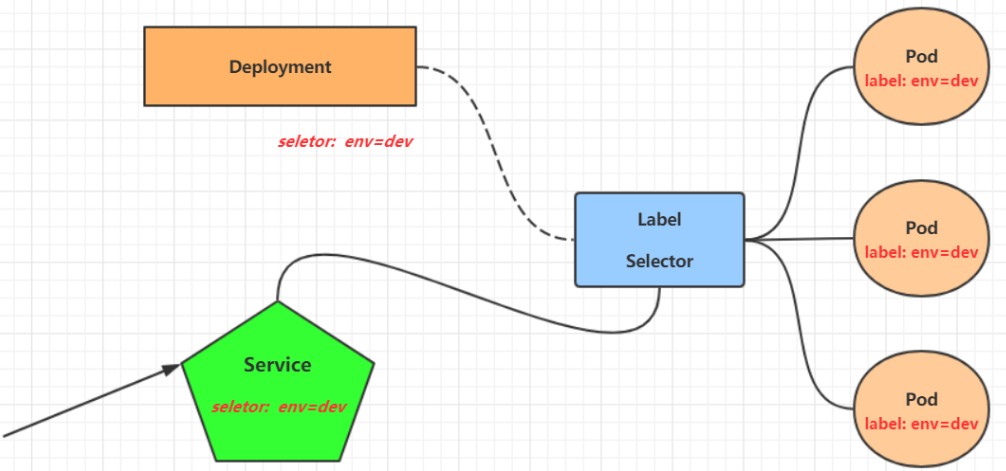
In many cases, service is just a concept. What really works is the Kube proxy service process. A Kube proxy service process is running on each Node. When creating a service, it will write the information of the created service to etcd through API server, and Kube proxy will find the change of this service based on the listening mechanism, and then it will convert the latest service information into the corresponding access rules.

kube - proxy currently supports three working modes:
userspace mode
In userspace mode, Kube proxy will create a listening port for each Service. The request sent to Cluster IP will be redirected to the listening port of Kube proxy by Iptables rules. Kube proxy will select a Pod providing services according to LB algorithm and establish a connection with it to forward the request to Pod. In this mode, Kube proxy acts as a four layer load balancer. Because Kube proxy runs in userspace, the data copy between kernel and user space will be increased during forwarding processing. Although it is relatively stable, it is inefficient.
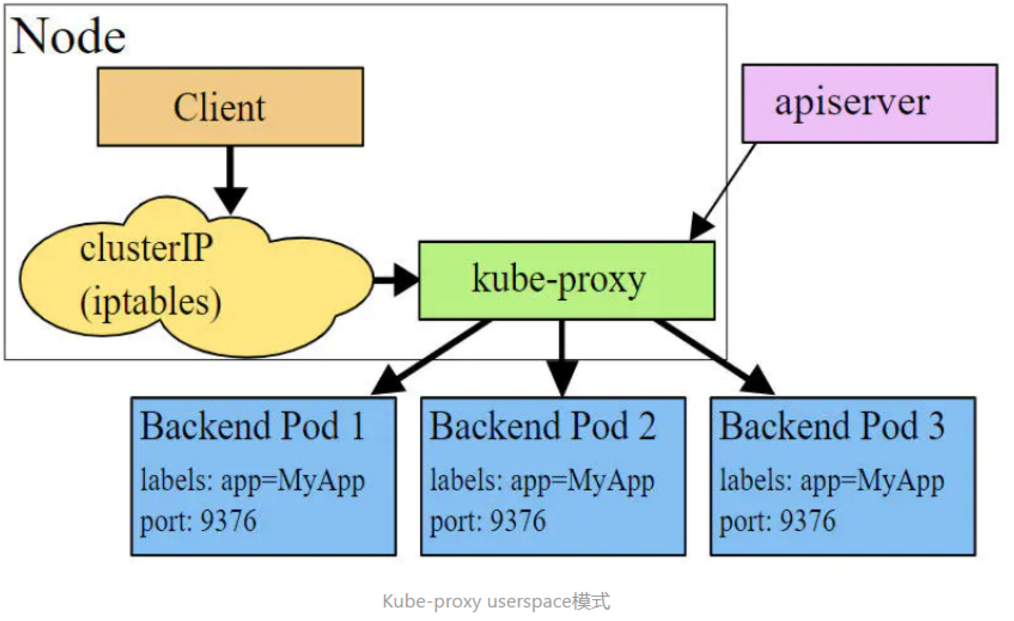
IPtables mode
In iptables mode, Kube proxy creates corresponding iptables rules for each Pod at the back end of the service, and directly redirects the request sent to the Cluster IP to a Pod IP. In this mode, Kube proxy does not assume the role of four-tier equalizer, but is only responsible for creating iptables rules. The advantage of this mode is that it is more efficient than the userspace mode, but it cannot provide a flexible LB strategy and cannot retry when the back-end Pod is unavailable.

IPv6 mode
ipvs mode is similar to iptables. Kube proxy monitors the changes of pod and creates corresponding ipvs rules. ipvs is more efficient than iptables. In addition, ipvs supports more LB algorithms.
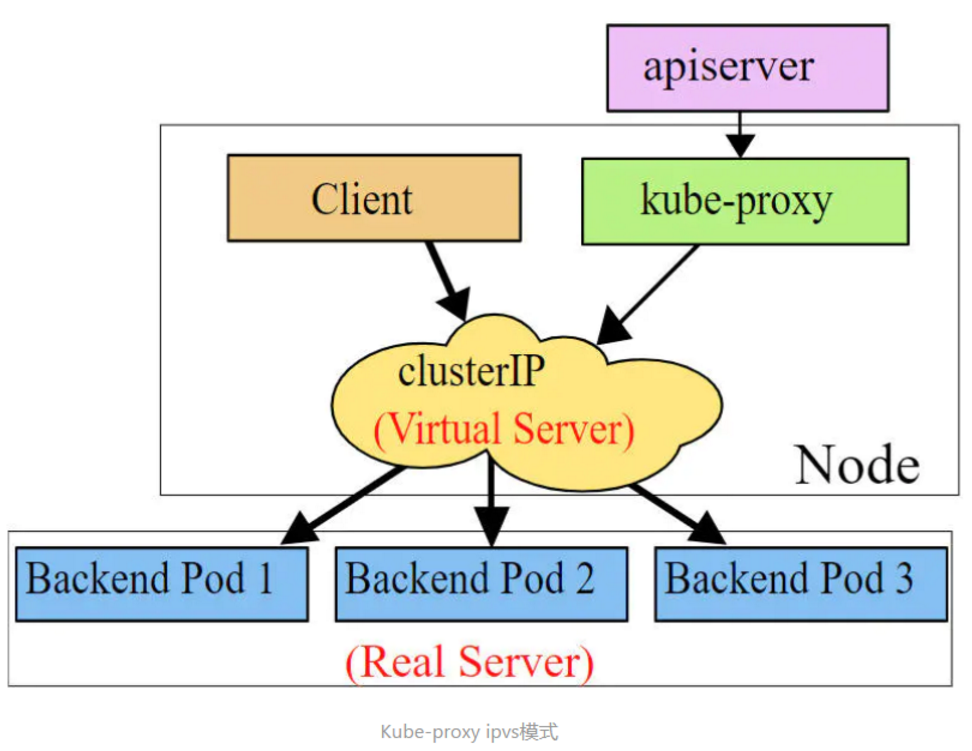
#The kernel must be installed in vsables mode, otherwise the kernel must be degraded #Turn on ipvs [root@k8s-master01 ~]# kubectl edit cm kube-proxy -n kube-system mode: "ipvs" #Modify mode [root@k8s-master01 ~]# kubectl delete pod -l k8s-app=kube-proxy -n kube-system pod "kube-proxy-4qpj7" deleted pod "kube-proxy-7s4bs" deleted pod "kube-proxy-pxbkz" deleted [root@k8s-master01 ~]# ipvsadm -Ln IP Virtual Server version 1.2.1 (size=4096) Prot LocalAddress:Port Scheduler Flags -> RemoteAddress:Port Forward Weight ActiveConn InActConn TCP 10.96.0.1:443 rr -> 10.10.10.130:6443 Masq 1 0 0 TCP 10.96.0.10:53 rr -> 10.244.0.4:53 Masq 1 0 0 -> 10.244.0.5:53 Masq 1 0 0 TCP 10.96.0.10:9153 rr -> 10.244.0.4:9153 Masq 1 0 0 -> 10.244.0.5:9153 Masq 1 0 0 TCP 10.102.96.95:443 rr -> 10.10.10.110:443 Masq 1 0 0 UDP 10.96.0.10:53 rr -> 10.244.0.4:53 Masq 1 0 0 -> 10.244.0.5:53 Masq 1 0 0
2. Service type
Resource manifest file for Service:
kind: Service # Resource type
apiVersion: v1 # Resource version
metadata: # metadata
name: service # Resource name
namespace: dev # Namespace
spec: # describe
selector: # Tag selector, which is used to determine which pod s are represented by the current service
app: nginx
type: # Service type, which specifies the access method of the service
clusterIP: # ip address of virtual service
sessionAffinity: # session affinity, which supports ClientIP and None
ports: # port information
- protocol: TCP
port: 3017 # service port
targetPort: 5003 # pod port
nodePort: 31122 # Host port- ClusterIP: the default value. It is the virtual IP assigned by Kubernetes system and can only be accessed inside the cluster
- NodePort: expose the Service to the outside through the port on the specified Node. Through this method, you can access the Service outside the cluster
- LoadBalancer: use the external load balancer to complete the load distribution to the service. Note that this mode needs the support of external cloud environment
- ExternalName: introduce services outside the cluster into the cluster and use them directly
3. Service usage
3.1 preparation of experimental environment
Before using the service, create three pods with Deployment. Note that set the tag app = nignx pod for the pod and create Deployment Yaml, as follows:
[root@k8s-master01 ~]# vim deployment.yaml
apiVersion: apps/v1
kind: Deployment
metadata:
name: pc-deployment
namespace: dev
spec:
replicas: 3
selector:
matchLabels:
app: nginx-pod
template:
metadata:
labels:
app: nginx-pod
spec:
containers:
- name: nginx
image: nginx:1.17.2
ports:
- containerPort: 80
#Create pod
[root@k8s-master01 ~]# kubectl create -f deployment.yaml
deployment.apps/pc-deployment created
#View pod details
[root@k8s-master01 ~]# kubectl get pods -n dev -o wide --show-labels
NAME READY STATUS RESTARTS AGE IP NODE NOMINATED NODE READINESS GATES LABELS
pc-deployment-6499c8d644-7khrf 1/1 Running 0 22s 10.244.2.9 k8s-node02 <none> <none> app=nginx-pod,pod-template-hash=6499c8d644
pc-deployment-6499c8d644-9bp6f 1/1 Running 0 22s 10.244.1.8 k8s-node01 <none> <none> app=nginx-pod,pod-template-hash=6499c8d644
pc-deployment-6499c8d644-p8qpw 1/1 Running 0 22s 10.244.2.8 k8s-node02 <none> <none> app=nginx-pod,pod-template-hash=6499c8d644
#For the convenience of subsequent testing, modify the index of three nginx HTML page
# kubectl exec -it container - n dev /bin/sh
# echo "ip" > /usr/share/nginx/html/index.html
#Check whether the modification is successful
[root@k8s-master01 ~]# curl 10.244.1.8
10.244.1.8
[root@k8s-master01 ~]# curl 10.244.2.9
10.244.2.9
[root@k8s-master01 ~]# curl 10.244.2.8
10.244.2.83.2 ClusterIP type Service
Create service clusterip yaml
[root@k8s-master01 ~]# vim service-clusterip.yaml
apiVersion: v1
kind: Service
metadata:
name: service-clusterip
namespace: dev
spec:
selector:
app: nginx-pod
clusterIP: #If the ip address of the service is not written, it will generate one by default
type: ClusterIP
ports:
- port: 80 #Service port
targetPort: 80 #pod port
#Create service
[root@k8s-master01 ~]# kubectl create -f service-clusterip.yaml
service/service-clusterip created
#View service
[root@k8s-master01 ~]# kubectl get svc -n dev -o wide
NAME TYPE CLUSTER-IP EXTERNAL-IP PORT(S) AGE SELECTOR
service-clusterip ClusterIP 10.98.88.209 <none> 80/TCP 10s app=nginx-pod
#View service details
#Here is a list of Endpoints, which is the service entry that the current service can load
[root@k8s-master01 ~]# kubectl describe svc service-clusterip -n dev
Name: service-clusterip
Namespace: dev
Labels: <none>
Annotations: <none>
Selector: app=nginx-pod
Type: ClusterIP
IP Family Policy: SingleStack
IP Families: IPv4
IP: 10.98.88.209
IPs: 10.98.88.209
Port: <unset> 80/TCP
TargetPort: 80/TCP
Endpoints: 10.244.1.8:80,10.244.2.8:80,10.244.2.9:80
Session Affinity: None
Events: <none>
#View the mapping rules of ipvs
[root@k8s-master01 ~]# ipvsadm -Ln
TCP 10.98.88.209:80 rr
-> 10.244.1.8:80 Masq 1 0 0
-> 10.244.2.8:80 Masq 1 0 0
-> 10.244.2.9:80 Masq 1 0 0
#Visit 10.98.88.209 to observe the effect
[root@k8s-master01 ~]# curl 10.98.88.209
10.244.2.9Endpoint
Endpoint is a resource object in Kubernetes. It is stored in etcd and used to record the access addresses of all pod s corresponding to a service. It is generated according to the selector description in the service configuration file.
A service consists of a group of pods, which are exposed through endpoints, which are the collection of endpoints that implement the actual service. That is, the connection between service and pod is realized through endpoints.
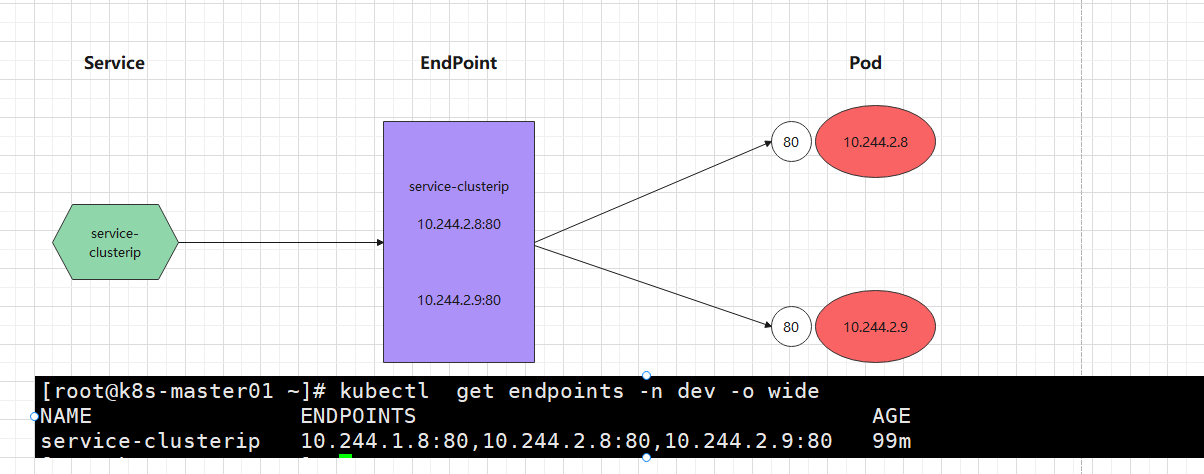
Load distribution policy
Access to services is distributed to the back-end Pod. At present, Kubernetes provides two load distribution strategies:
- If it is not defined, the Kube proxy policy is used by default, such as random and polling
- Session persistence mode based on client address, that is, all requests from the same client will be forwarded to a fixed Pod. This mode can add the 'sessionAffinity:ClientIP' option to the spec
# View the mapping rules of ipvs [rr polling] [root@k8s-master01 ~]# ipvsadm -Ln TCP 10.98.88.209:80 rr -> 10.244.1.8:80 Masq 1 0 0 -> 10.244.2.8:80 Masq 1 0 0 -> 10.244.2.9:80 Masq 1 0 0 #Cyclic access test [root@k8s-master01 ~]# while true;do curl 10.98.88.209;sleep 5;done; 10.244.2.9 10.244.2.8 10.244.1.8 10.244.2.9 10.244.2.8 10.244.1.8 #Modify distribution policy - sessionAffinity:ClientIP # [root@k8s-master01 ~]# ipvsadm -Ln TCP 10.98.88.209:80 rr persistent 10800 -> 10.244.1.8:80 Masq 1 0 0 -> 10.244.2.8:80 Masq 1 0 0 -> 10.244.2.9:80 Masq 1 0 0 #Cyclic access test [root@k8s-master01 ~]# while true;do curl 10.98.88.209;sleep 5;done; 10.244.2.9 10.244.2.9 10.244.2.9 #Delete servcie [root@k8s-master01 ~]# kubectl delete -f service-clusterip.yaml service "service-clusterip" deleted
3.3 Service of headliner type
In some scenarios, developers may not want to use the load balancing function provided by the service, but want to control the load balancing strategy by themselves. In this case, kubernetes provides a header service, which does not assign Cluster IP. If you want to access the service, you can only query through the domain name of the service.
Create service headline yaml
[root@k8s-master01 ~]# vim service-headliness.yaml
apiVersion: v1
kind: Service
metadata:
name: service-headliness
namespace: dev
spec:
selector:
app: nginx-pod
clusterIP: None #Set clusterIP to None to create the headline service
type: ClusterIP
ports:
- port: 80
targetPort: 80
#Create service
[root@k8s-master01 ~]# kubectl create -f service-headliness.yaml
service/service-headliness created
#Get the service and find that CLUSTER-IP is not allocated
[root@k8s-master01 ~]# kubectl get svc service-headliness -n dev -o wide
NAME TYPE CLUSTER-IP EXTERNAL-IP PORT(S) AGE SELECTOR
service-headliness ClusterIP None <none> 80/TCP 17s app=nginx-pod
#View service details
[root@k8s-master01 ~]# kubectl describe svc service-headliness -n dev
Name: service-headliness
Namespace: dev
Labels: <none>
Annotations: <none>
Selector: app=nginx-pod
Type: ClusterIP
IP Family Policy: SingleStack
IP Families: IPv4
IP: None
IPs: None
Port: <unset> 80/TCP
TargetPort: 80/TCP
Endpoints: 10.244.1.8:80,10.244.2.8:80,10.244.2.9:80
Session Affinity: None
Events: <none>
#Check the resolution of the domain name
[root@k8s-master01 ~]# kubectl exec -it pc-deployment-6499c8d644-7khrf -n dev /bin/bash
kubectl exec [POD] [COMMAND] is DEPRECATED and will be removed in a future version. Use kubectl exec [POD] -- [COMMAND] instead.
root@pc-deployment-6499c8d644-7khrf:/# cat /etc/resolv.conf
nameserver 10.96.0.10
search dev.svc.cluster.local svc.cluster.local cluster.local
options ndots:5
root@pc-deployment-6499c8d644-7khrf:/# exit
exit
[root@k8s-master01 ~]# dig @10.96.0.10 service-headliness.dev.svc.cluster.local
;; ANSWER SECTION:
service-headliness.dev.svc.cluster.local. 30 IN A 10.244.2.9
service-headliness.dev.svc.cluster.local. 30 IN A 10.244.1.8
service-headliness.dev.svc.cluster.local. 30 IN A 10.244.2.8
3.4 NodePort type Service
In the previous case, the ip address of the created service can only be accessed inside the cluster. If you want to expose the service to the outside of the cluster, you need to use another type of service, called NodePort. The working principle of NodePort is to map the port of the service to a port of the Node, and then you can access the service through NodeIP: NodePort.

Create service nodeport yaml
[root@k8s-master01 ~]# vim service-nodeport.yaml
apiVersion: v1
kind: Service
metadata:
name: service-nodeport
namespace: dev
spec:
selector:
app: nginx-pod
type: NodePort #service type
ports:
- port: 80
nodePort: 30003 #Specify the port of the bound node (the default value range is 30000-32767). If it is not specified, it will be assigned by default
targetPort: 80
#Create service
[root@k8s-master01 ~]# kubectl create -f service-nodeport.yaml
service/service-nodeport created
#View service
[root@k8s-master01 ~]# kubectl get svc -n dev -o wide
NAME TYPE CLUSTER-IP EXTERNAL-IP PORT(S) AGE SELECTOR
service-nodeport NodePort 10.102.216.64 <none> 80:30003/TCP 25s app=nginx-pod
#Next, you can access the 30002 port of any nodeip in the cluster through the browser of the computer host, and you can access the pod 
3.5 LoadBalancer type Service
LoadBalancer is similar to NodePort. The purpose is to expose a port to the outside. The difference is that LoadBalancer will build a load balancing device outside the cluster. If the device needs the support of the external environment, the requests sent by external services to the device will be loaded by the device and forwarded to the cluster.
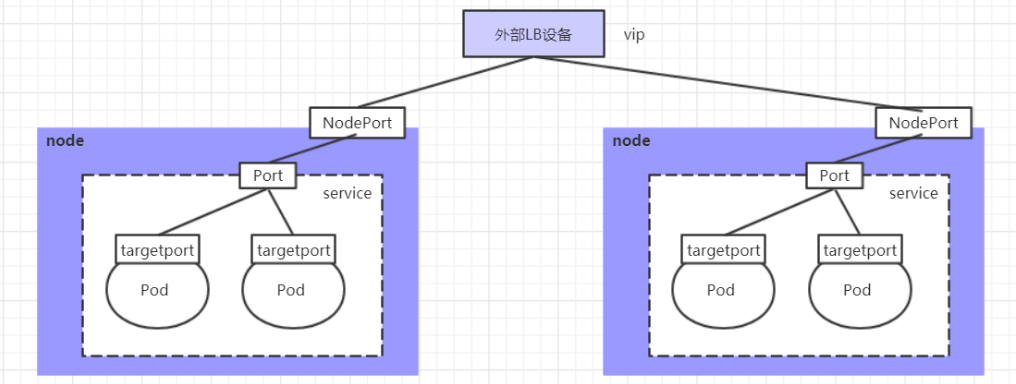
3.6 Service of externalname type
The Service of externalname type is used to introduce the external Service of the cluster. It specifies the address of an external Service through the externalname attribute, and then accesses the Service inside the cluster to access the external resources.
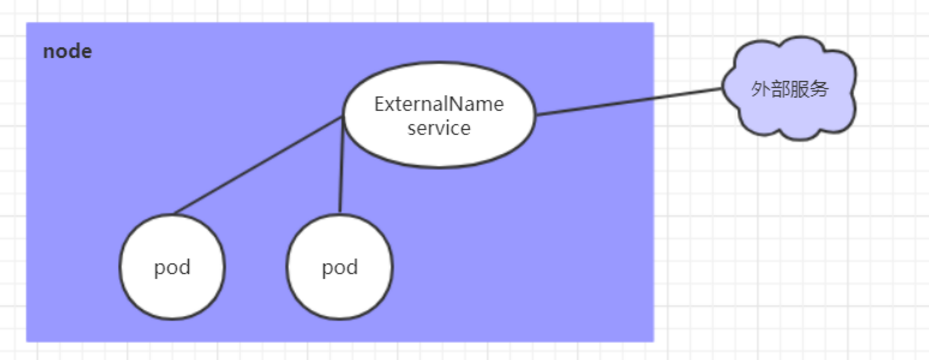
[root@k8s-master01 ~]# vim service-externalname.yaml apiVersion: v1 kind: Service metadata: name: service-externalname namespace: dev spec: type: ExternalName #service type externalName: www.baidu.com #It can also be changed to ip #Create pod [root@k8s-master01 ~]# kubectl create -f service-externalname.yaml service/service-externalname created #Domain name resolution [root@k8s-master01 ~]# dig @10.96.0.10 service-externalname.dev.svc.cluster.local www.baidu.com. 30 IN CNAME www.a.shifen.com. www.a.shifen.com. 30 IN A 110.242.68.4 www.a.shifen.com. 30 IN A 110.242.68.3
4. Introduction to ingress
There are two main ways for Service to expose services outside the cluster: NotePort and LoadBalancer, but both of them have a certain disadvantage:
- The disadvantage of NodePort mode is that it will occupy many ports of cluster machines. When there are more cluster services, this disadvantage will become more and more obvious
- The disadvantage of LB mode is that each service needs an lb, which is wasteful and troublesome, and requires the support of devices other than kubernetes
Based on this situation, kubernetes provides an ingress resource object. Ingress only needs one NodePort or one LB to meet the needs of exposing multiple services. The working mechanism is roughly as follows:
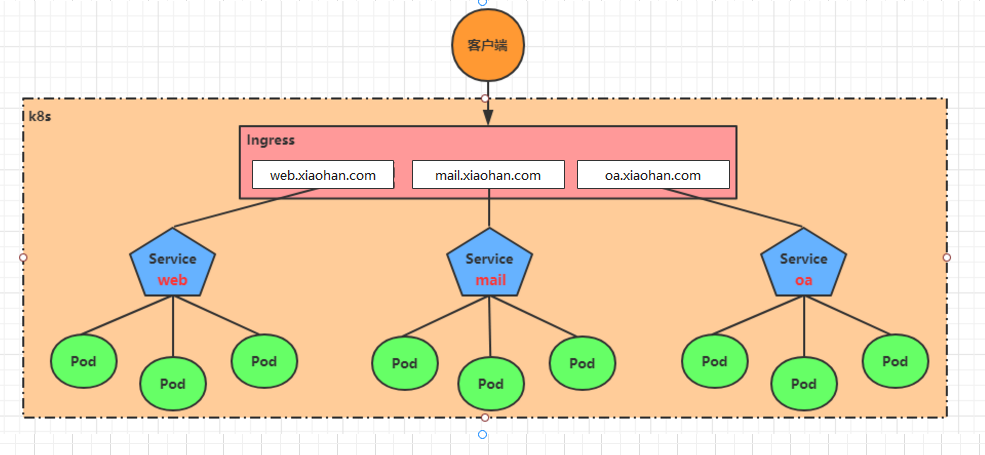
In fact, ingress is equivalent to a 7-tier load balancer. It is an abstraction of kubernetes' reverse proxy. Its main working principle is similar to Nginx. It can be understood as establishing many mapping rules in ingress. Ingress Controller monitors these configuration rules and converts them into Nginx's reverse proxy configuration, and then provides services to the outside. There are two core concepts:
- Ingress: an object in kubernetes that defines rules for how to forward to a service
- ingress controller: it is a specific program to realize reverse proxy and load balancing. It parses the rules defined by ingress and realizes request forwarding according to the configured rules. There are many implementation methods, such as Nginx, Contour, Haproxy and so on
The working principle of Ingress (taking Nginx as an example) is as follows:
-
The user writes an Ingress rule to specify which domain name corresponds to which Service in the kubernetes cluster
-
The Ingress controller dynamically senses the changes of Ingress service rules, and then generates a corresponding Nginx reverse proxy configuration
-
The Ingress controller will write the generated Nginx configuration to a running Nginx service and update it dynamically
-
So far, what is really working is an Nginx, which is internally configured with user-defined request forwarding rules
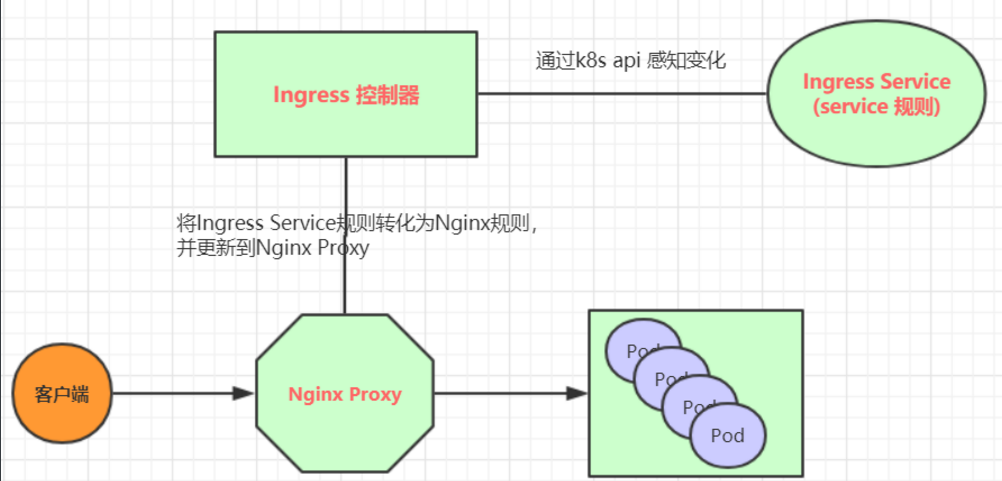
5. Use of ingress
5.1 environmental preparation - build an ingress environment
#Download yaml file
[root@k8s-master01 ingress-nginx]# wget https://raw.githubusercontent.com/kubernetes/ingress-nginx/controller-v1.1.0/deploy/static/provider/cloud/deploy.yaml
#Foreign images can only be pulled by scientific Internet access. Here we can pull domestic images (all three nodes need to be pulled)
[root@k8s-master01 ingress-nginx]# docker pull dyrnq/controller:v1.1.0
[root@k8s-master01 ingress-nginx]# docker pull dyrnq/kube-webhook-certgen:v1.1.1
#Modify deploy Yaml configuration file, change the image address into the image address downloaded above
image: dyrnq/kube-webhook-certgen:v1.1.1
image: dyrnq/controller:v1.1.0
#Service needs to be modified
spec:
type: NodePort
externalTrafficPolicy: Cluster
ipFamilyPolicy: SingleStack
ipFamilies:
- IPv4
ports:
- name: http
port: 80
protocol: TCP
targetPort: http
appProtocol: http
nodePort: 30080
- name: https
port: 443
protocol: TCP
targetPort: https
appProtocol: https
nodePort: 30443
#Create ingress nginx
[root@k8s-master01 ingress-nginx]# kubectl apply -f deploy.yaml
#Check whether the creation is successful
[root@k8s-master01 ingress-nginx]# kubectl get svc -n ingress-nginx
NAME TYPE CLUSTER-IP EXTERNAL-IP PORT(S) AGE
ingress-nginx-controller NodePort 10.105.40.71 <none> 80:30080/TCP,443:30443/TCP 6m40s
ingress-nginx-controller-admission ClusterIP 10.97.46.45 <none> 443/TCP 6m40s
[root@k8s-master01 ingress-nginx]# kubectl get po -n ingress-nginx
NAME READY STATUS RESTARTS AGE
ingress-nginx-admission-create-67sv5 0/1 Completed 0 8m7s
ingress-nginx-admission-patch-jczwb 0/1 ImagePullBackOff 0 8m7s
ingress-nginx-controller-67f6979dd8-7gpmj 1/1 Running 0 8m7sPrepare service and pod
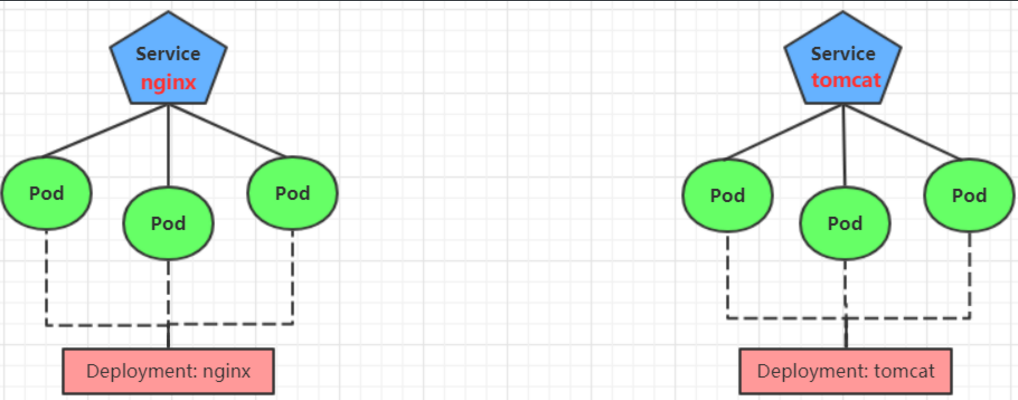
Create Tomcat nginx yaml
[root@k8s-master01 ~]# vim tomcat-nginx.yaml
apiVersion: apps/v1
kind: Deployment
metadata:
name: nginx-deployment
namespace: dev
spec:
replicas: 3
selector:
matchLabels:
app: nginx-pod
template:
metadata:
labels:
app: nginx-pod
spec:
containers:
- name: nginx
image: nginx:1.17.2
ports:
- containerPort: 80
---
apiVersion: apps/v1
kind: Deployment
metadata:
name: tomcat-deployment
namespace: dev
spec:
replicas: 3
selector:
matchLabels:
app: tomcat-pod
template:
metadata:
labels:
app: tomcat-pod
spec:
containers:
- name: tomcat
image: tomcat:8.5-jre10-slim
ports:
- containerPort: 8080
---
apiVersion: v1
kind: Service
metadata:
name: nginx-service
namespace: dev
spec:
selector:
app: nginx-pod
clusterIP: None
type: ClusterIP
ports:
- port: 80
targetPort: 80
---
apiVersion: v1
kind: Service
metadata:
name: tomcat-service
namespace: dev
spec:
selector:
app: tomcat-pod
clusterIP: None
type: ClusterIP
ports:
- port: 8080
targetPort: 8080
#establish
[root@k8s-master01 ~]# kubectl create -f tomcat-nginx.yaml
deployment.apps/nginx-deployment created
deployment.apps/tomcat-deployment created
service/nginx-service created
service/tomcat-service created
#see
[root@k8s-master01 ~]# kubectl get svc -n dev
NAME TYPE CLUSTER-IP EXTERNAL-IP PORT(S) AGE
nginx-service ClusterIP None <none> 80/TCP 16s
tomcat-service ClusterIP None <none> 8080/TCP 16s5.2 Http agent
Create ingress http yaml
[root@k8s-master01 ~]# vim ingress-http.yaml
apiVersion: networking.k8s.io/v1
kind: Ingress
metadata:
name: ingress-http
namespace: dev
spec:
ingressClassName: nginx
rules:
- host: nginx.xiaohan.com
http:
paths:
- path: /
pathType: Prefix
backend:
service:
name: nginx-service
port:
number: 80
- host: tomcat.xiaohan.com
http:
paths:
- path: /
pathType: Prefix
backend:
service:
name: tomcat-service
port:
number: 8080
#establish
[root@k8s-master01 ~]# kubectl create -f ingress-http.yaml
ingress.networking.k8s.io/ingress-http created
#see
[root@k8s-master01 ~]# kubectl get ing ingress-http -n dev
NAME CLASS HOSTS ADDRESS PORTS AGE
ingress-http nginx nginx.xiaohan.com,tomcat.xiaohan.com 10.105.40.71 80 92s
[root@k8s-master01 ~]# kubectl describe ing ingress-http -n dev
Name: ingress-http
Labels: <none>
Namespace: dev
Address: 10.105.40.71
Default backend: default-http-backend:80 (<error: endpoints "default-http-backend" not found>)
Rules:
Host Path Backends
---- ---- --------
nginx.xiaohan.com
/ nginx-service:80 (10.244.1.2:80,10.244.1.6:80,10.244.1.7:80 + 3 more...)
tomcat.xiaohan.com
/ tomcat-service:8080 (10.244.1.5:8080,10.244.1.8:8080,10.244.2.6:8080)
Annotations: <none>
Events:
Type Reason Age From Message
---- ------ ---- ---- -------
Normal Sync 86s (x2 over 118s) nginx-ingress-controller Scheduled for sync
# Next, configure the host file on the local computer and resolve the above two domain names to 192.168.109.100(master)
# Then, you can access Tomcat. Com separately xiaohan. COM: 32240 and nginx xiaohan. COM: 32240 see the effect5.3 Https agent
Create certificate
#Generate certificate [root@k8s-master01 ~]# openssl req -x509 -sha256 -nodes -days 365 -newkey rsa:2048 -keyout tls.key -out tls.crt -subj "/C=CN/ST=BJ/L=BJ/O=nginx/CN=xiaohan.com" Generating a 2048 bit RSA private key ...............................................................................+++ ...................................+++ writing new private key to 'tls.key' ----- #Create secret key [root@k8s-master01 ~]# kubectl create secret tls tls-secret --key tls.key --cert tls.crt secret/tls-secret created
Create ingress HTTPS yaml
[root@k8s-master01 ~]# cat ingress-https.yaml
apiVersion: networking.k8s.io/v1
kind: Ingress
metadata:
name: ingress-https
namespace: dev
spec:
ingressClassName: nginx
tls:
- host:
- nginx.xiaohan.com
- tomcat.xiaohan.com
secret:
name: tls-secret #Specify secret key
rules:
- host: nginx.xiaohan.com
http:
paths:
- path: /
pathType: Prefix
backend:
service:
name: nginx-service
port:
number: 80
- host: tomcat.xiaohan.com
http:
paths:
- path: /
pathType: Prefix
backend:
service:
name: tomcat-service
port:
number: 8080